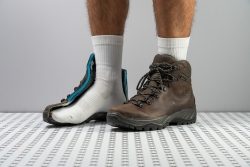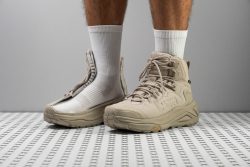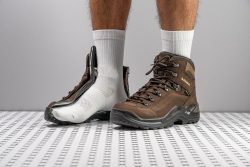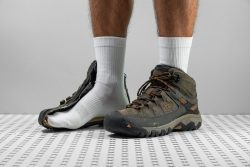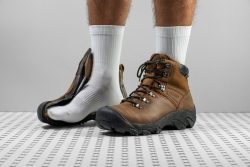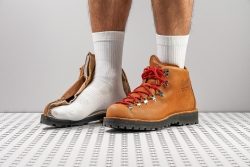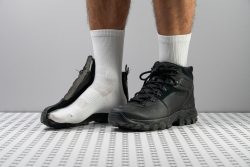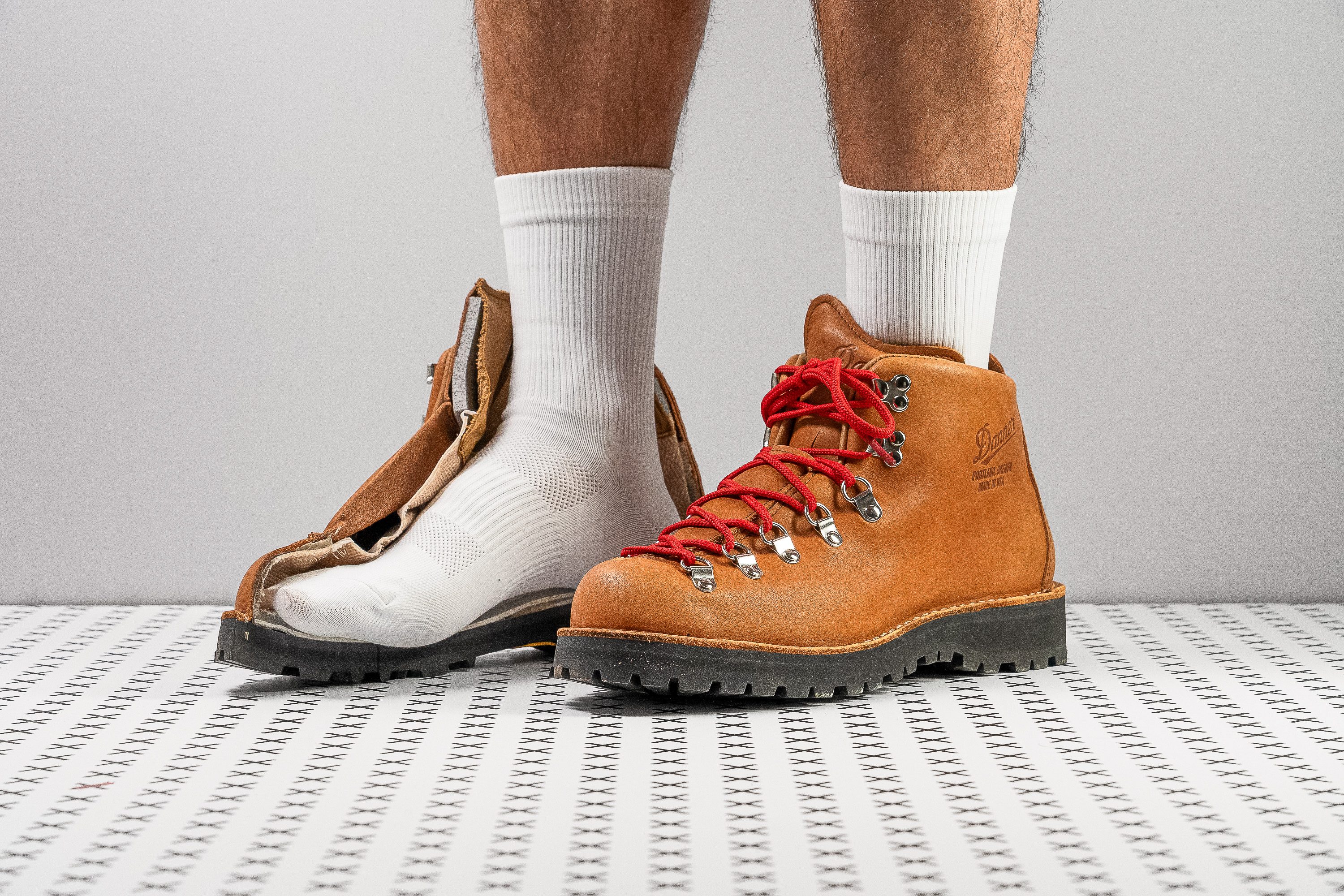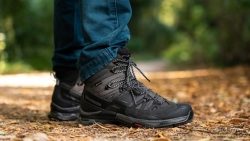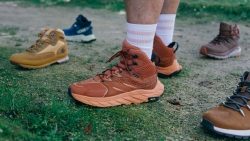7 Best Leather Hiking Boots in 2025
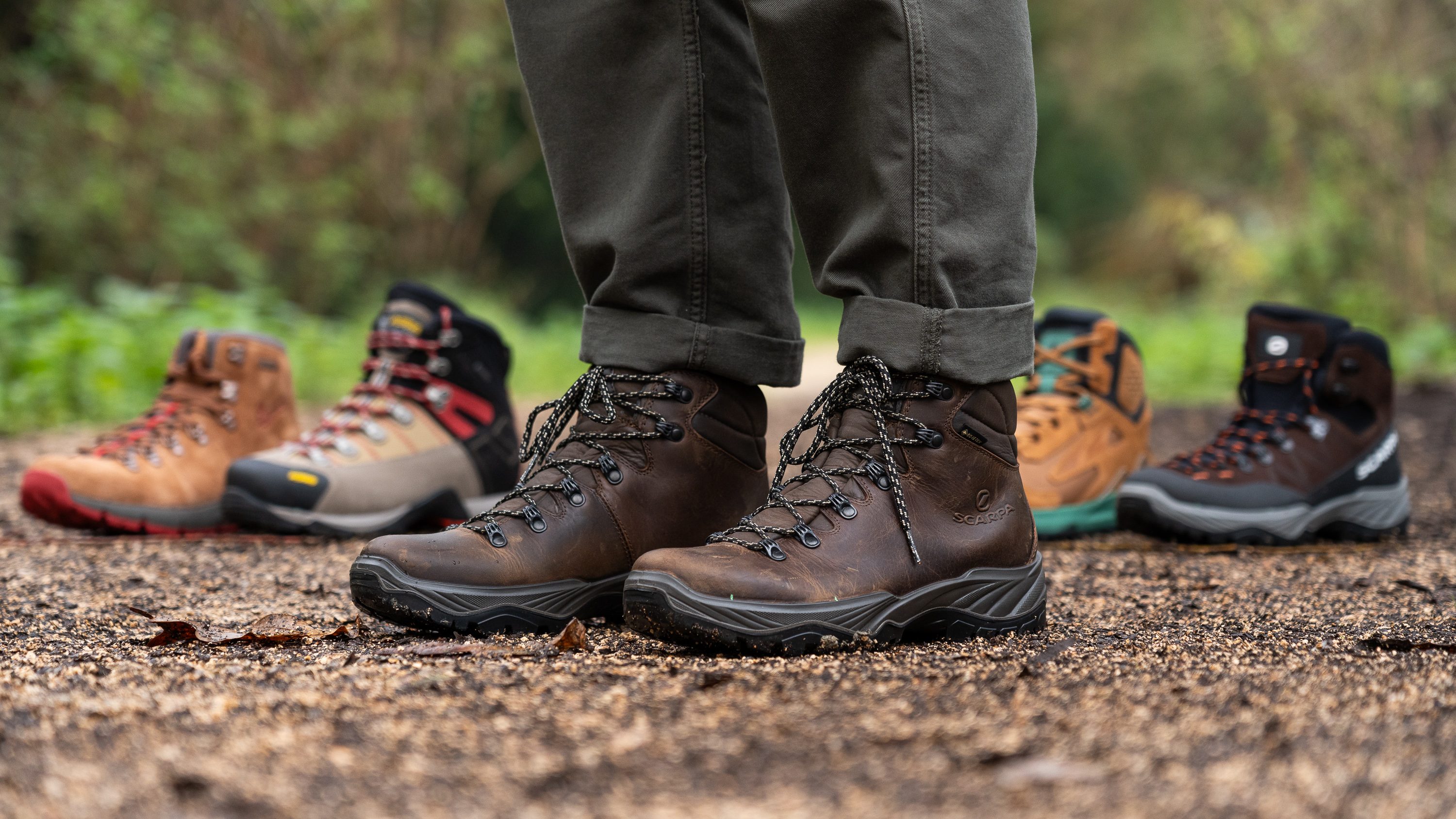
We buy shoes ourselves. We earn commissions when you buy through us, at no extra cost. Why trust us
There is just something special about experiencing the great outdoors in a pair of leather hiking boots. These hikers are naturally tough, and their grounded design makes mixing and matching—to complete your backcountry outfit—an easy feat.
We’ve subjected leather hiking boots to field tests and lab tests.
Are you in need of a smashing all-rounder? Maybe you’re into a lightweight pair? Or perhaps something powerful for backpack adventures? Whichever it is, if it’s leather, you’re in the right place.
How we test leather hiking boots
This selection of top-of-the-line leather hiking boots is a product of dedication and passion. Here’s our approach:
- We buy leather hiking boots using our own funds. This way, we can be as objective and straightforward with our reviews as possible.
- Each leather boot goes through a series of tests. In every pair, we hike on various terrains for days, come rain or shine.
- We collect and analyze data by carrying out different tests in our lab. We also tear apart the boots to clearly view the sandwich of components inside, especially the cushioning system.
- One test that is particularly interesting for leather hiking boots is the toebox durability, where we intentionally damage the toebox with our Dremel and assess the durability on a 1-5 scale.
Best leather hiking boots overall
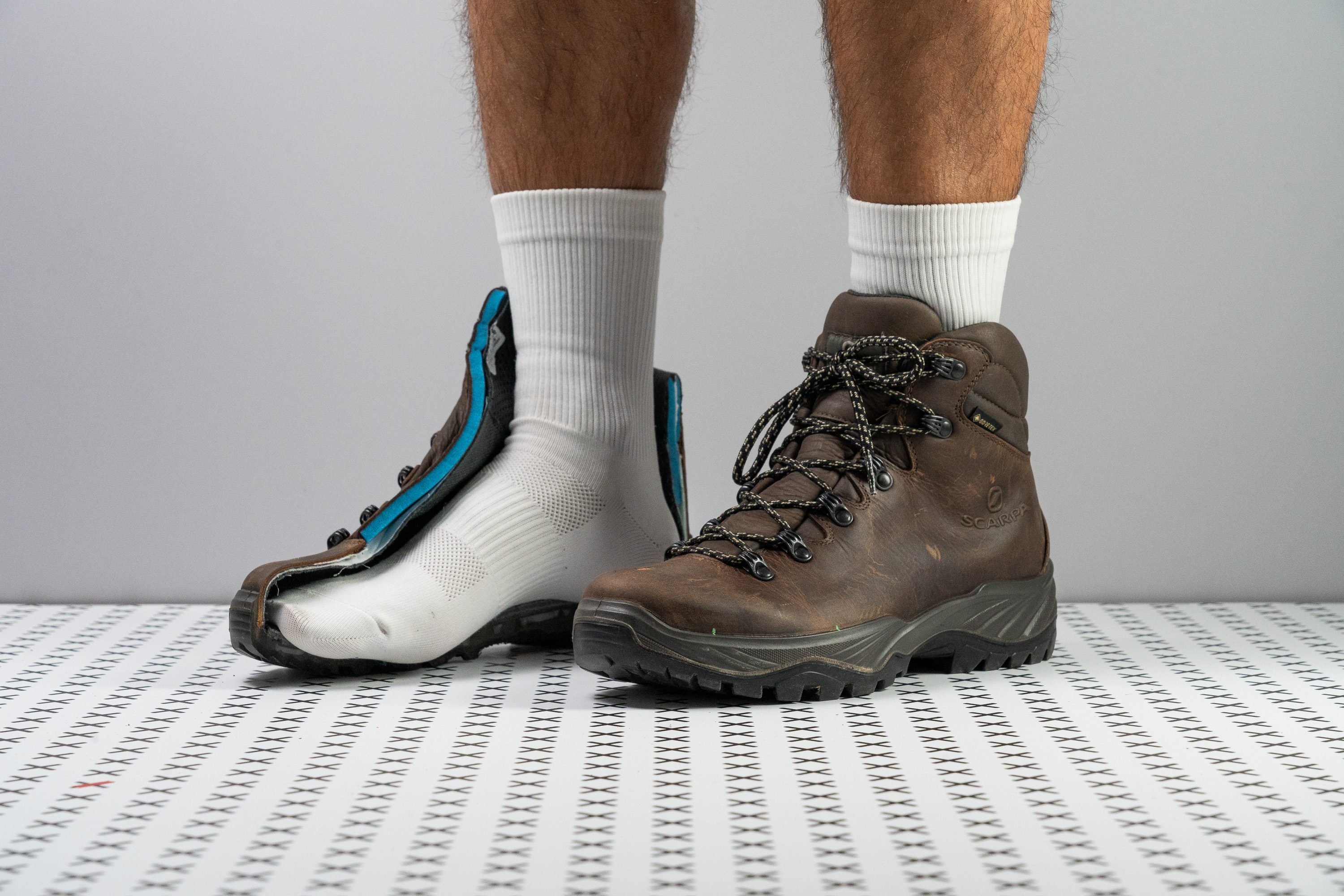







































What makes it the best?
After thorough wear tests and lab analysis, the Scarpa Terra GTX emerged as our ultimate leather hiking boot. It provides unparalleled support and protection on rugged terrains. With its robust construction, stable ride, and exceptional grip, we felt we could conquer any trail.
The Terra GTX kept us safe even when navigating cold and wet terrain. Its solid leather upper seals our feet from unwanted elements—cold air, water, and debris—as confirmed by our tests. In addition, its 5/5 durability is unmatched, as evidenced by its resilience against our brutal Dremel.
We felt confident in this pair as its firm and grounded platform gave a lot of surface feedback that allowed us to adapt accordingly. Our durometer reveals its cushion is 16.1% tougher than average—a promising sign that it won’t bottom out even under heavy loads. True enough, we had no wobbles as we carried heavy backpacks. Our ankles also felt supported without any discomfort to our Achilles.
The Vibram outsole carried us safely through wet, dry, soft, and compact surfaces. It’s tough enough to handle anything and is insanely grippy even for the slickest surfaces, thanks to its 4-mm sticky and multidirectional lugs.
Measuring 110.5 mm in the forefoot and 84.1 mm in the heel, it runs a little narrow. We recommend those with broad feet to consider alternative options.
Pros
- Glue-like underfoot, even on wet surfaces
- Insanely comfortable
- Reliably stable and supportive ride
- Resilient and high-quality build
- Durable Vibram outsole
- Watertight and warm
- Quick break-in time
- Performs consistently in the cold
- Strong ankle support
Cons
- Quite heavy
- Cushioning could be better
- Scuff magnet
Leather hiking boots with the best shock absorption
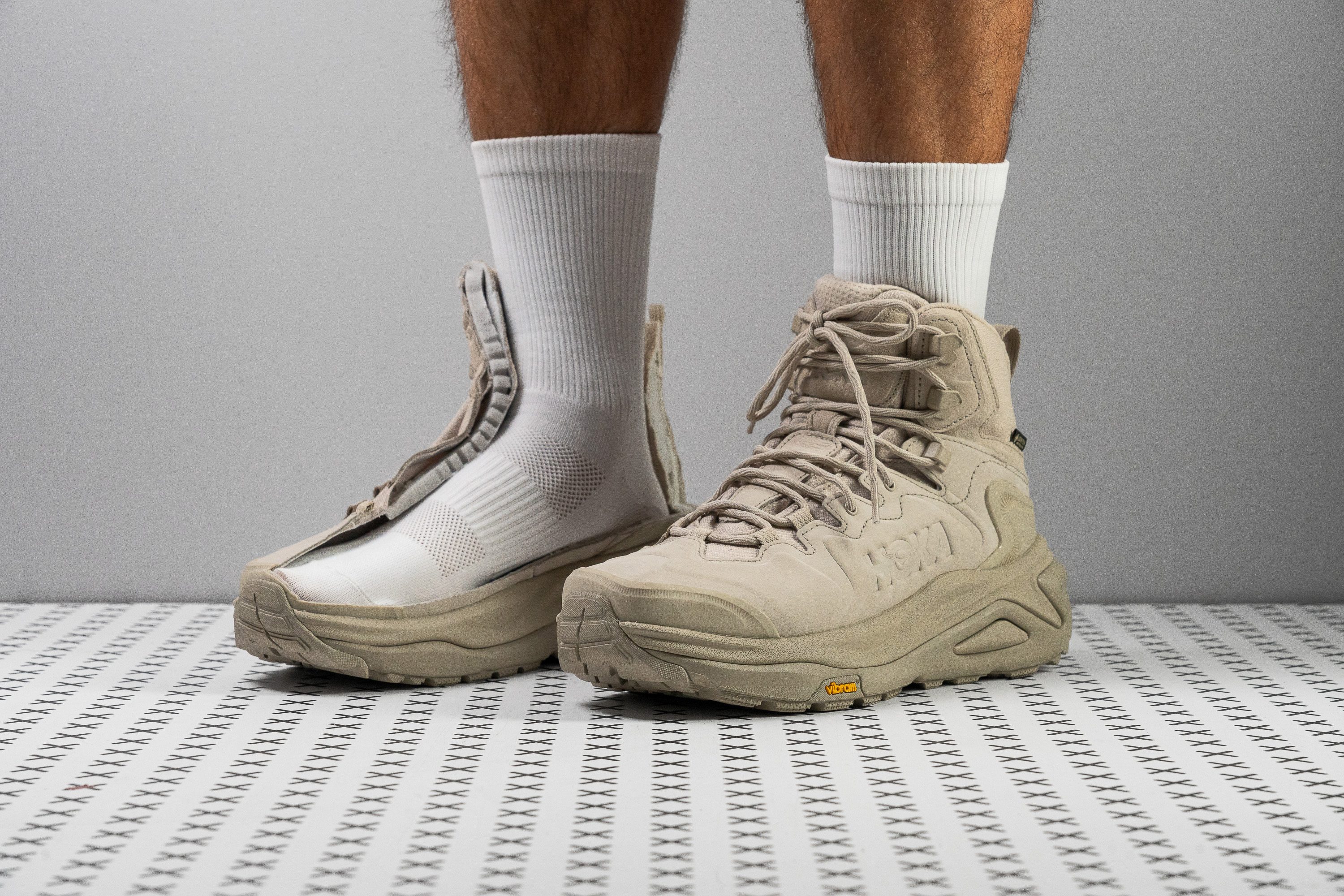
















































What makes it the best?
The Hoka Kaha 3 GTX is protective all around, from its impermeable nubuck leather upper to its thick cushioning in the midsole, and to its grippy Vibram Megagrip outsole. It delivers the comfort we need for long distances, and our lab tests verify that it blessed us with the best shock absorption among leather hiking boots.
Kaha 3 GTX offers bottomless comfort in its mega 41.9/30.4 mm stack. Besides its height, the foam itself can reduce the forces of each landing. In our shock absorption test, it rated a superb 120 SA, making it 29.0% more protective than average.
The upper proved to be waterproof as well, keeping us dry in rainy and river crossing encounters. Our 1/5 breathability proves its effectiveness, since not a wisp of smoke could escape the upper.
In the outsole, we measured the Vibram Megagrip’s traction, and it impressed with a 0.65 friction score, mirroring the confident footing we experienced during our treks. It features shallow 3.2 mm lugs, which shine best in rocky and hard-packed trails. However, we found the lugs to be lacking in muddy terrain.
Pros
- One of the best cushioned boots ever
- Extremely comfortable for long miles
- Highly stable and supportive
- Excellent traction on smooth surfaces
- Grips mixed and hilly terrain well
- Contains sustainable materials
- More streamlined than the Kaha 2
Cons
- Lugs got much shallower
- Heavier than average
Best leather boots for backpacking
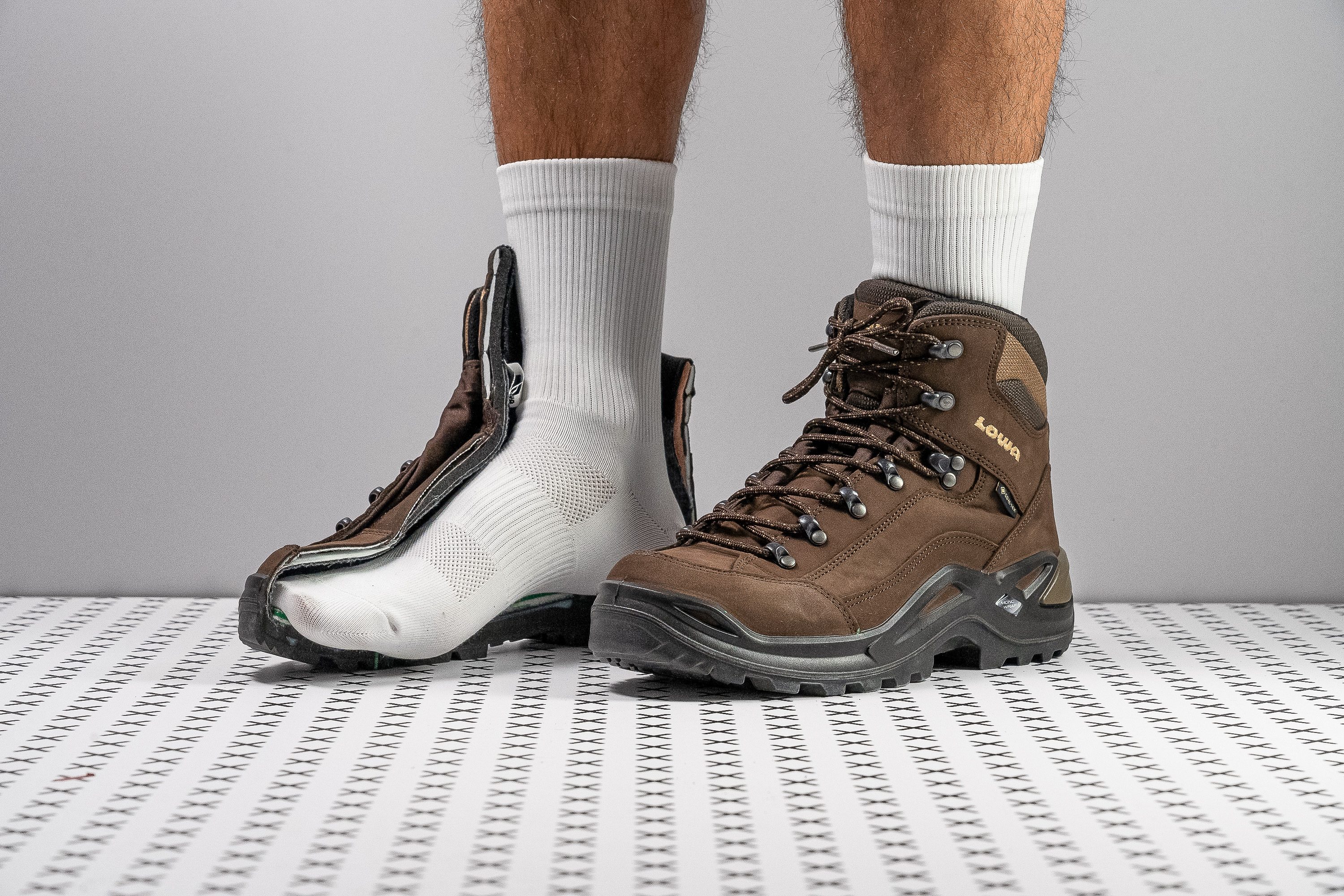



















































What makes it the best?
The Lowa Renegade GTX Mid ran the gauntlet of our lab tests and days on the trail. This tank of a boot passed our assessments with flying colors, with special attention going to its first-rate stability, incredible durability of the toe box, and perfect waterproofing. This stylish leather boot completely knocks the socks off the competition and we voted it the best leather hiking boots for backpacking.
With a slew of features contributing to its outstanding stability, we have rarely encountered a boot as stable as the Lowa Renegade GTX Mid. A rigid nylon shank in the midsole offers a high torsional rigidity, which measured 5/5 in our lab tests - where 5 is the most rigid. The midsole is cunningly crafted to allow our feet to nestle into it instead of hovering above it, which lends a whole other dimension to the stable feeling of the boot. On rough trails, over rocks or scree, we always felt as surefooted as a mountain goat.
The tough leather upper withstood a load of battering on our test hikes, so we put it to the test in our lab. Setting our Dremel to 5K RPM and applying 3.2N of pressure, we set to work on the toe box. After 12 seconds, only the smallest scuff remained as proof of our attack! The solid leather construction of this boot is tough as nails, and our feet feel protected for the long haul in the Lowa Renegade GTX Mid.
Boasting a Gore-Tex lining, we already trust the Renegade GTX Mid to not let any water in. Coupled, however, with the nubuck leather upper and fully gusseted tongue, this boot is completely watertight. Our feet stayed bone dry splashing through streams, and as an added bonus, the sticky Vibram outsole worked just as well underwater as on dry land!
This boot tapers rapidly around the toe, making this boot unsuitable for hikers with wide feet. Measuring it in the lab, we found it to be 72.3 mm wide around the toe, which is 6.4 mm narrower than average. We recommend hikers looking for a roomier toe box to look at other options.
Pros
- Extremely supportive and stable ride
- Lightweight build
- Strong ankle support
- Excellent grip in dry and wet conditions
- Great backpacking companion
- Old-school nubuck leather upper
- Keeps our feet warm and dry
- Consistent performance in the cold
- Feels good out of the box
Cons
- Pricey
- Lots of seams in upper construction
- Finnicky lacing
- Too warm for summer hikes
Most breathable leather hiking boots
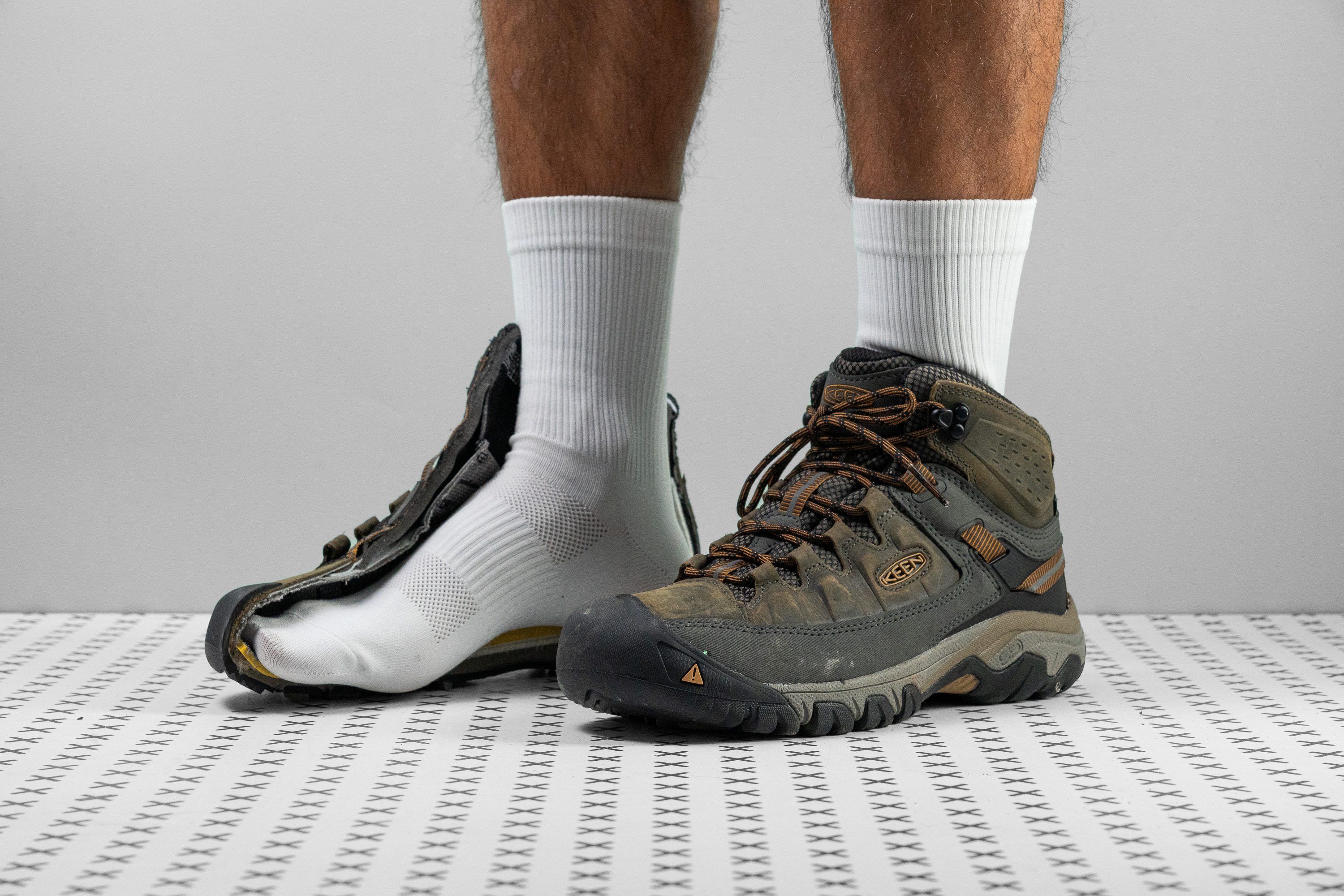










































What makes it the best?
KEEN Targhee III Waterproof Mid stands out as our top choice for breathability among leather hiking boots in our lab. Its ability to keep our feet ventilated while remaining watertight during hikes impressed us, making it a stellar option for tackling rugged terrains without sacrificing comfort. Priced at $145, it offers these exceptional features without breaking the bank.
Despite its tough exterior, this boot provides a padded interior, ensuring a comfortable fit. Under the microscope, its compact and interlocked braided fibers with minimal gaps strike a balance between waterproofing and breathability. With a remarkable 2/5 score in our lab tests, it proves its effectiveness in keeping water out while allowing airflow. Featuring a toe bumper, it provides additional protection from rocks, enhancing durability.
The ride feels inherently stable due to its firm midsole, supportive shanks, and grippy lugs. Our durometer confirms a 31.1 HA measurement, 22.4% tougher than average, yet we feel cushioned enough from harsh landings. The shoe's additional support and 4.2 mm multidirectional lugs help us feel well-planted and surefooted, even as we carry loaded backpacks.
Balancing all the rigidity is its longitudinal flexibility to enhance a natural feel. Our bend test reveals it’s 31.8% more adaptive than the average boot.
Because this is still a waterproof shoe, it inevitably feels stuffy during the summer.
Pros
- Extremely stable
- Great ankle support
- Generously padded and comfortable
- Secure heel hold
- Flexible
- Budget-friendly price
- Laudable warmth
- Performs very well in the cold
- Excellent grip on various terrain
- Short to zero break-in period
- Commendable toe cap
- Roomy toebox
Cons
- Stuffy in the summer
- Lackluster outsole durability
- Firm midsole
- Not ideal for narrow feet
Best leather hiking boots with wide toeboxes
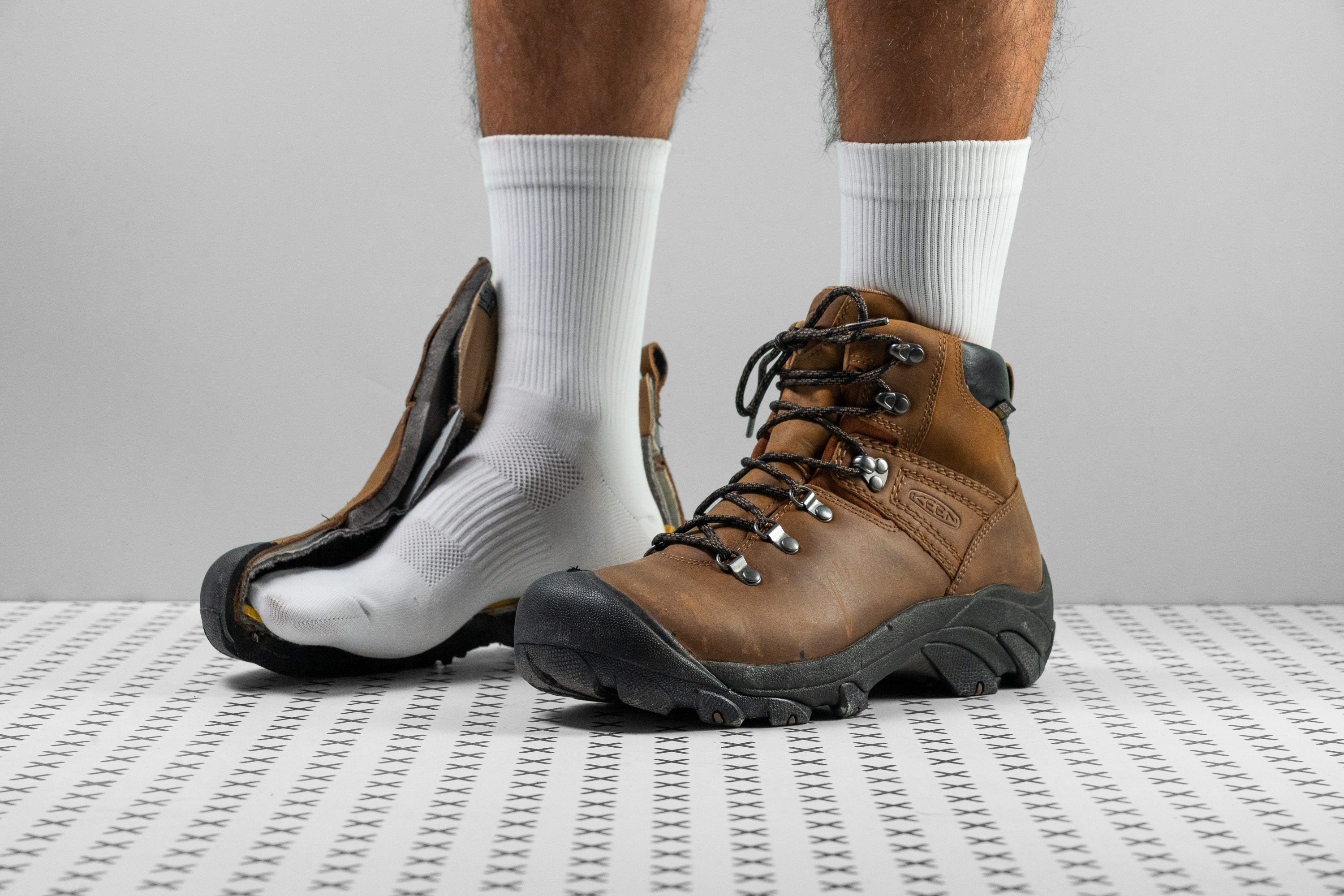











































What makes it the best?
We cut open and hiked with leather boots and discovered KEEN Pyrenees offers the best wide toebox. With its premium nubuck leather and mighty build, this pair offers exceptional stability and protection. On top of that, we find it immensely cozy for all-day wear, especially in colder seasons.
Pyrenees doesn’t hinder our toe splay in any way. The toebox is a generous 108.0 mm and doesn't taper around the big toe area. It's a whopping 83.5 mm! We have lots of room to find our footing with every stride. Our hikes feel stable thanks to the stiff shank in the midfoot and the firm foothold that prevents awkward missteps.
Our feet feel at home straight away with the plush platform. Our durometer confirms it's 40.2% softer than average. Pyrenees pairs a generous heel stack for impact protection and a humble forefoot for enhanced ground control. This creates a massive 18.1 mm drop, which is extremely supportive and relieving when we’re carrying heavy backpacks.
All around, Pyrenees screams protection. Its tough leather build and secure lockdown shields us from cold winds and water. Underfoot, the KEEN.ALL-TERRAIN compound is one of the toughest we measured in our lab (92.0 HC) for extra protection from jagged rocks.
Contrary to its name, the outsole doesn’t grip well on all terrains. We found ourselves feeling unsteady on mud and snow.
Pros
- Premium nubuck leather quality
- Top-notch waterproofing
- Tons of impact protection
- Surprisingly soft cushioning
- Excellent stability and support
- Very wide, accommodating toebox
- Convenient lacing system
Cons
- Too bulky and heavy
- Tongue edges dig into shins
- Lacks traction for mud, ice, and snow
Best budget leather hiking boots
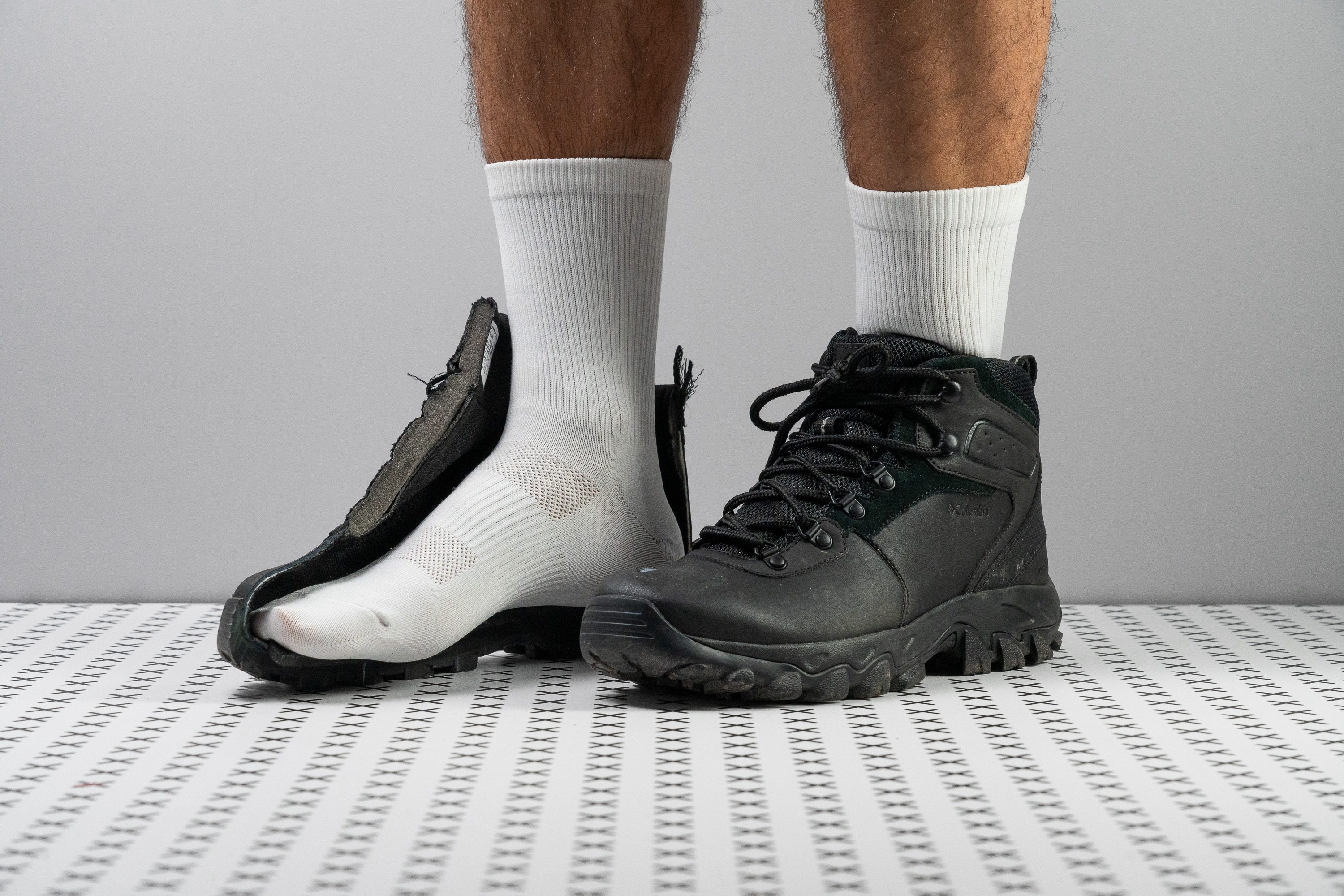







































What makes it the best?
Of all the leather hiking boots we tested in and out of the lab, Columbia Newton Ride Plus II Waterproof satisfies the outdoor adventurer’s cravings without breaking the bank. At only $100, it offers support and traction in a minimal package for more enjoyable treks in the wild. It’s undoubtedly our best budget pick given that the average hiking boot costs $210.
Despite having a leather upper, this boot achieved its light 16.5 oz (468g) weight. Being 11.9% below average, it preserves our leg freshness and prolongs comfort.
The platform offers a grounded sensation with its moderate 33.7/23.9 mm stack. Together with its generous width of 115.9/88.5 mm and twist-proof construction, we felt confident in our footing.
Also ensuring our surefooted strides are the deep 4.7 mm lugs that display their unwavering grasp on loose dirt, soft sand, and wet rocks. Together with the thick 3.7 mm outsole, these served as our underfoot shield from sharp debris.
However, we can’t recommend this boot for serious backpacking. Its extended collar lacks ankle support and serves more as a shield against scrapes and slashes.
Pros
- Comfortable step-in feel
- Lightweight construction
- Affordable price point
- Lively and responsive ride
- Stable and grounded base
- Flexible forefoot
Cons
- Ineffective waterproofing
- Not much ankle support
- Not very durable
Genuine leather isn’t always good
Genuine is a term that is widely used today, but, unfortunately, it does not mean what it implies. Because there are no legal ramifications to this, manufacturers promote something as genuine leather, even if it’s products that have only a sliver of leather, some leather fibers, and a lot of filler.
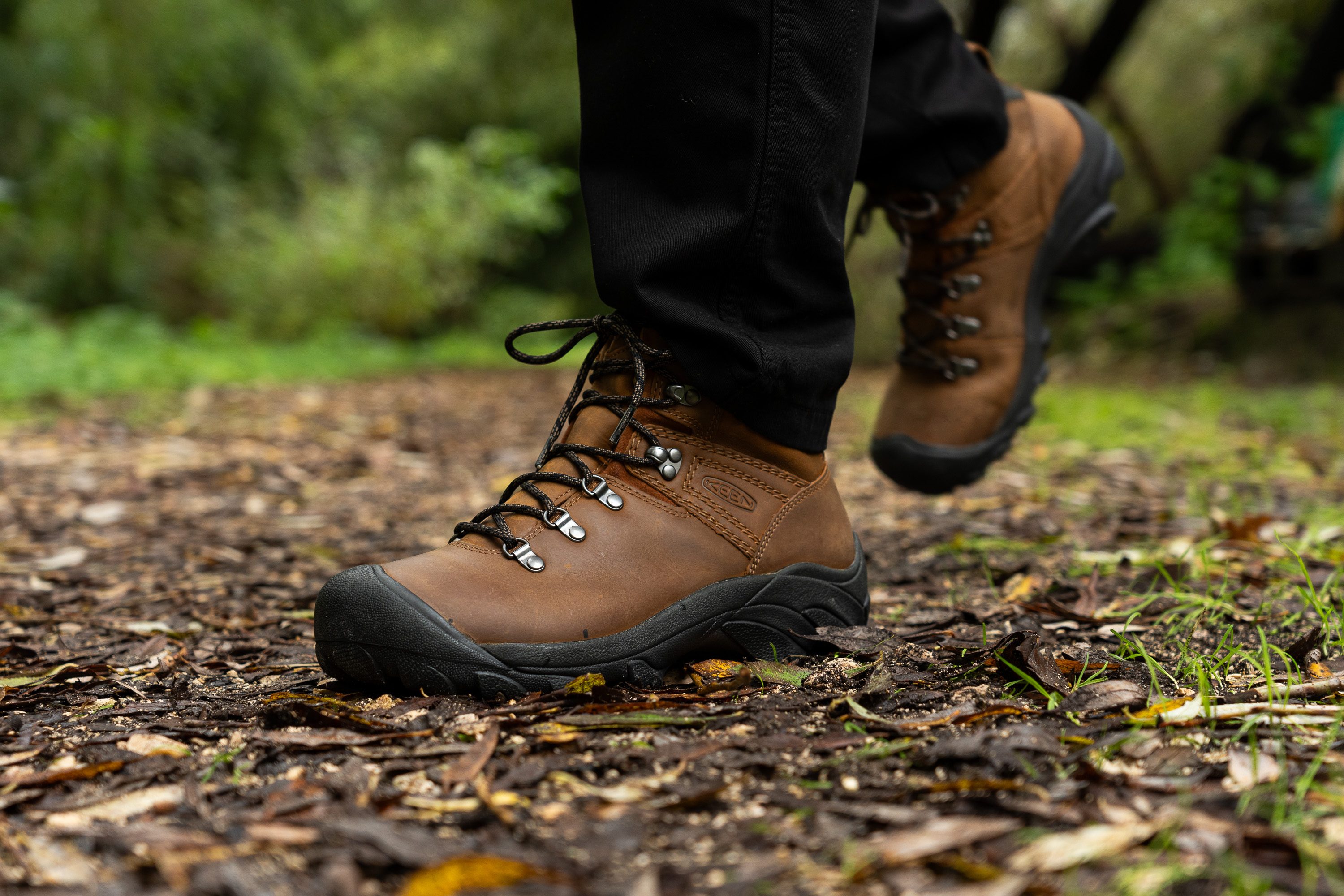
Of course, high-quality hand-made leather products can be marked as genuine, but today this is a rarity. Unfortunately, in most cases, genuine leather means low-quality leather.
How to recognize high-quality leather
When examining the leather, look at the raw edge where it was cut and at the backside. For easier determination, here’s the comparison between low-quality and high-quality leather.
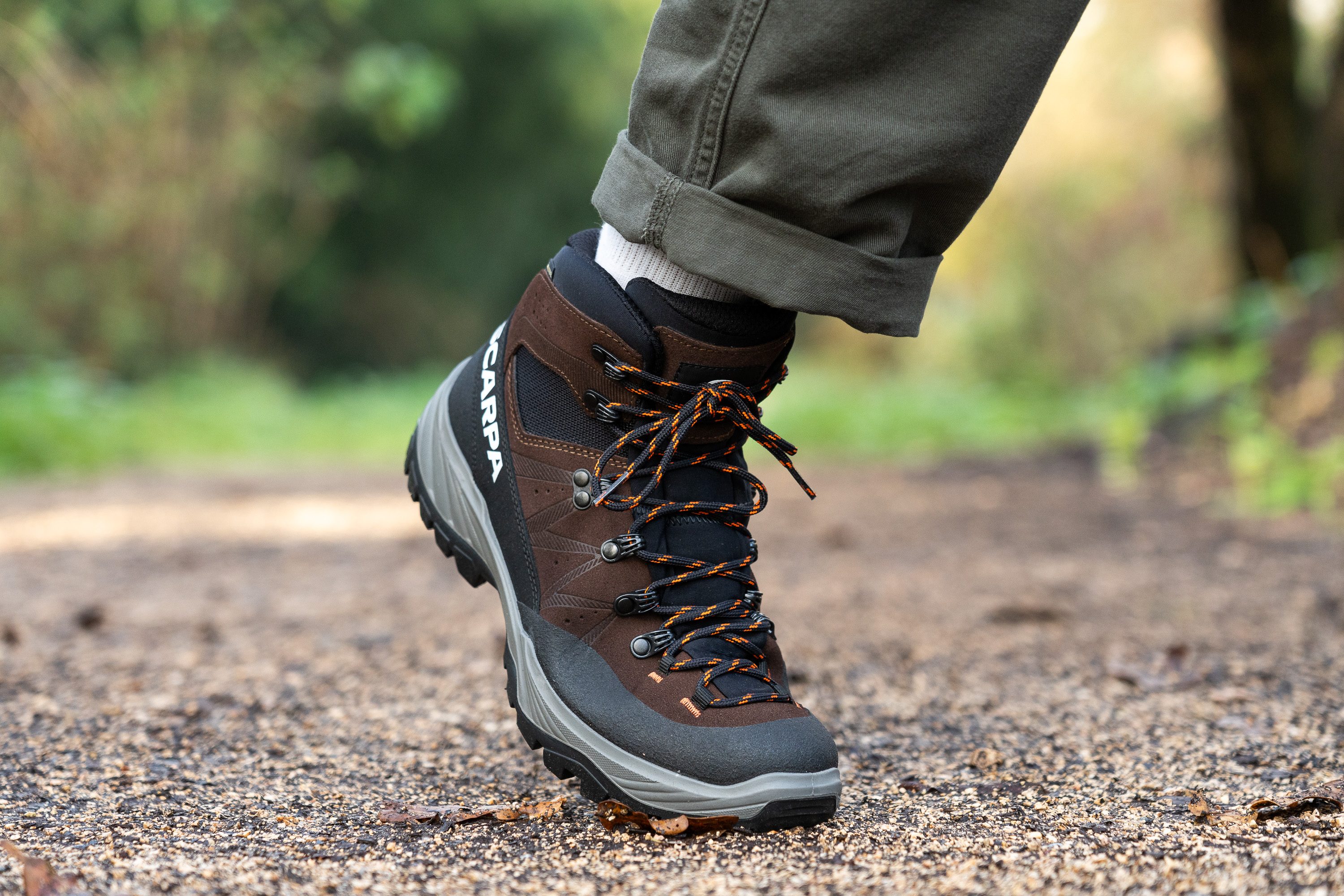
|
Features of cheaper leather
|
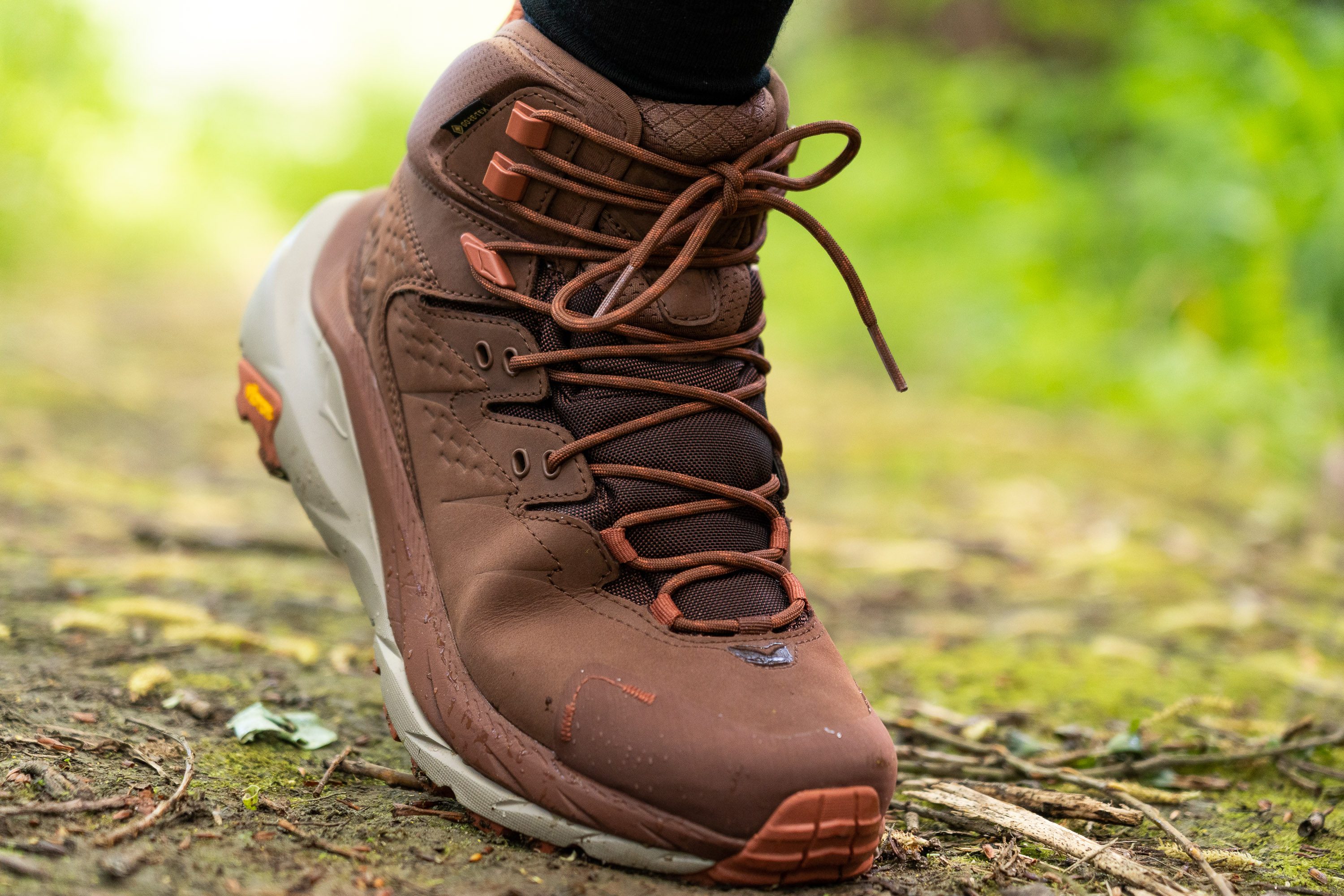
|
Features of expensive, high-quality leather
|
Nubuck, suede, full grain, splits
Don’t get confused. Here’s what you need to know.
- Full-grain leather or top-grain leather is made from the top of the hide. It’s the strongest part of the leather. High quality. Very durable.

- Nubuck leather is a full-grain leather that has a smooth feel thanks to brushing and sanding.
- Split leather is the part that comes when the top leather is removed. It’s a leftover and of low quality. It is less durable and less moisture-resistant than full-grain leather.
- Suede is made from split leather and it’s derived from the underside of animal skin, which is why it feels and looks fuzzy. It’s also soft and nice to the touch. Depending on the tannery, it can be very high- or very low-quality.
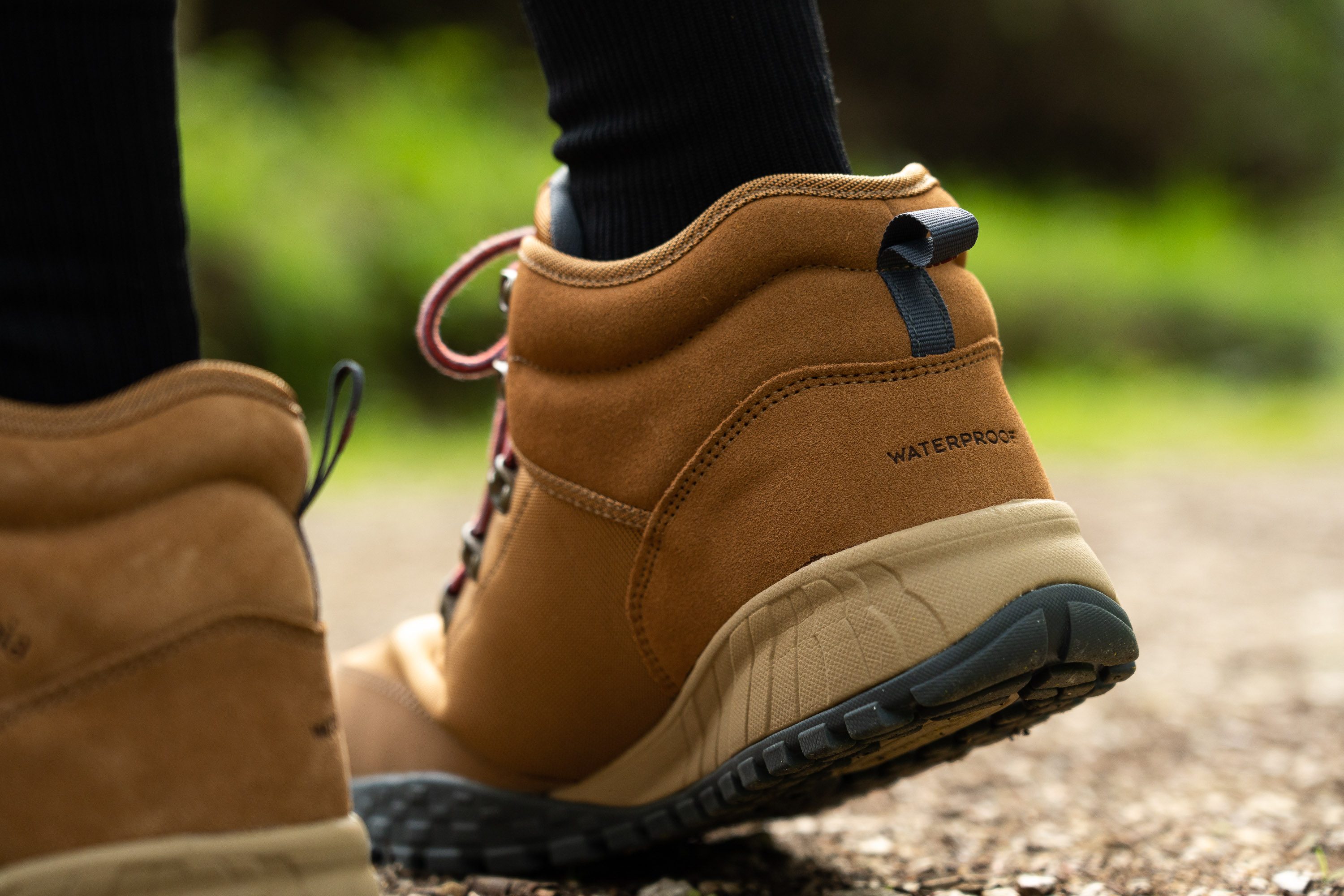
Burning the leather to test the quality
We usually perform this test in sneakers, where it's more difficult to figure out the quality of the leather and whether it’s leather at all. When we burn the upper material, there are 2 options:
- We see multiple layers; it’s fake (not leather)
- The material chars, and when we scratch it, we can see the grain of the leather, which means it’s real leather
How real leather burns and chars (test performed in RunRepeat lab)
Smells are also different; the real leather smells like burnt hair. When burning the leather, it’s easy to notice whether it was just the pigment that gave it the color or if it also has some plastic in it.
Burn test: discovering fake leather (test performed in RunRepeat lab)
Pros of wearing leather hiking boots
Leather hiking boots are classics. They are (in general) known to be durable and reliable. The specific pros of leather boots we want to highlight are:
- Durability. Leather is not easily scuffed like mesh and it tends to withstand different weather conditions easily.
- Natural waterproofness (to some degree), and they can be laminated with a waterproof layer when necessary.
- Natural breathability (to some degree). Leather does not have ventilation holes and is surely not as breathable as mesh, for example, but it is a natural material and can offer some breathability.
- The high-quality ones can be resoled when the upper is not damaged. Some manufacturers even offer this at no cost or at an affordable price.
- Leather is easily treated to look new (or newer). There are specialized creams and oils that can help prolong the life of leather and keep it looking fresh.
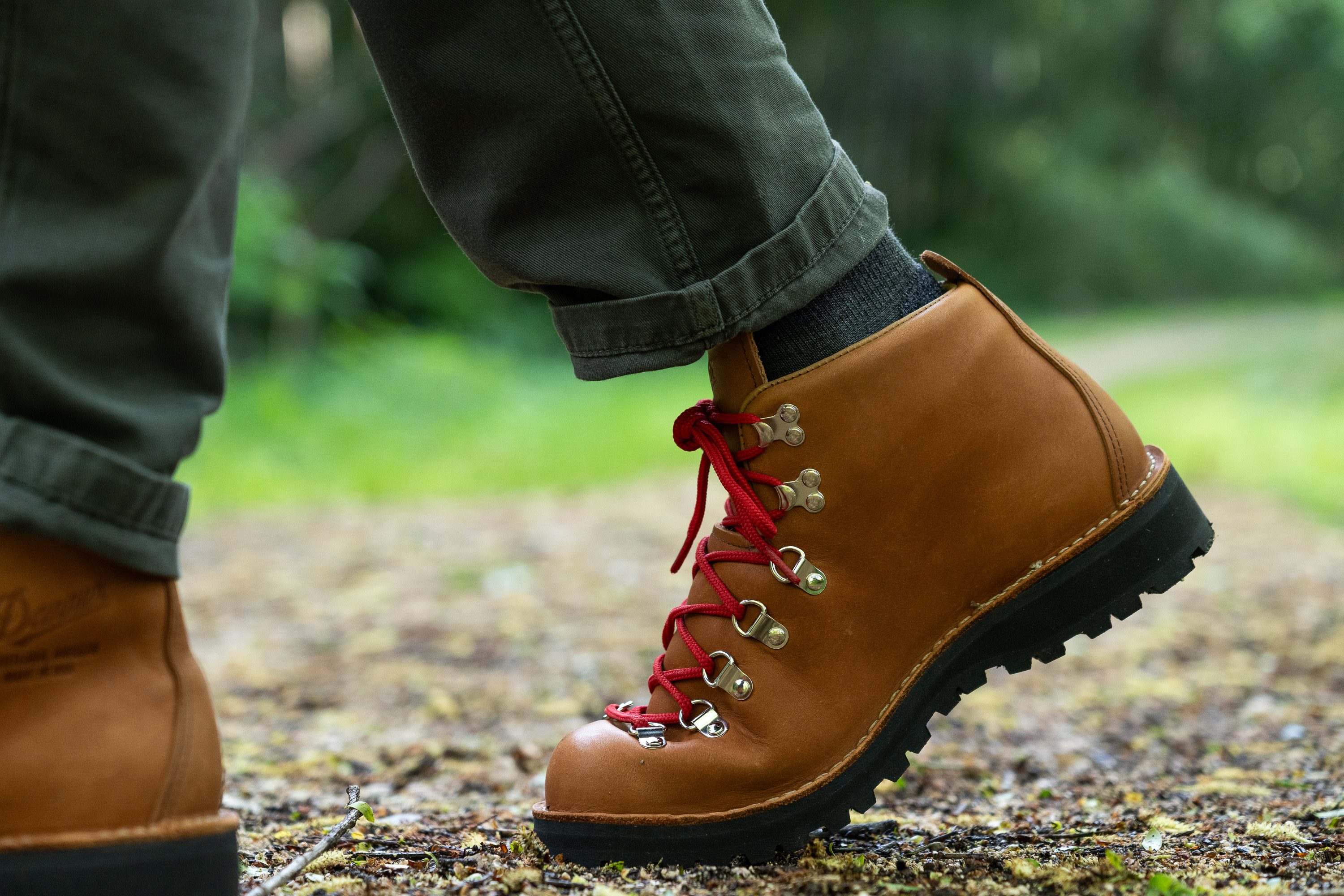
Cons of wearing leather hiking boots
- The break-in period is usually longer than in boots made of mesh or other softer materials. While the leather used on, say, sneakers can be thin and soft, the one used for hiking boots is usually thick and sturdy. This is because it has to be durable and to keep the ankle in place.
- Leather boots weigh more than synthetic ones.
- When the leather is of high quality, the price tends to be steep.
- Animal cruelty. There are many sources on this topic and, while it is obvious that the source is of animal origin, there are some manufacturers who claim that they use the leather of the animals who were killed for different reasons (not leather). This way, the leather does not end up in the landfill. Fortunately, there are many more materials available now, some even from sustainable sources, so there are other eco-friendly alternatives.
- It might be difficult to distinguish the real (high-quality) leather from the very cheap one that is mostly fillings but is advertised as top-notch.
Alternatives: mesh, knit
In hiking footwear, we often see combinations of materials. Even when 50% of the boot is made of leather, it’s good to know what else you’ve got in the box and what you can expect.
|
Material |
Pros |
Cons |
|
Leather |
Durable Naturally waterproof |
Needs break-in Heavy |
|
Mesh |
Breathable Lightweight |
Not so durable Not so flexible |
|
Knit |
Stretchy Pliable |
Often include plastics Not so breathable |
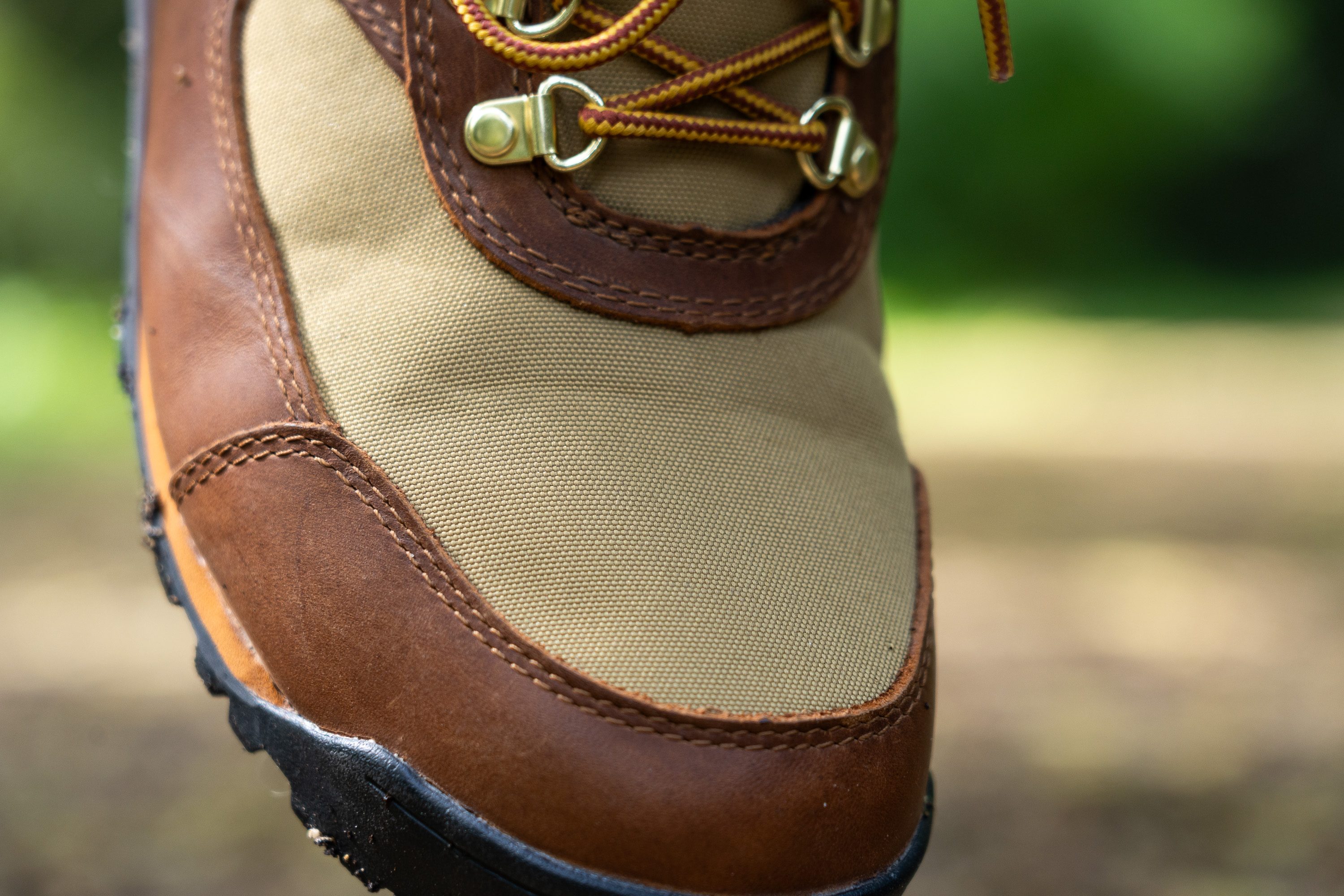
What’s inside leather hiking boots?
Depends on the model. Fortunately, we cut them all in half, so you can have a look. Or, read our in-depth reviews to learn more.
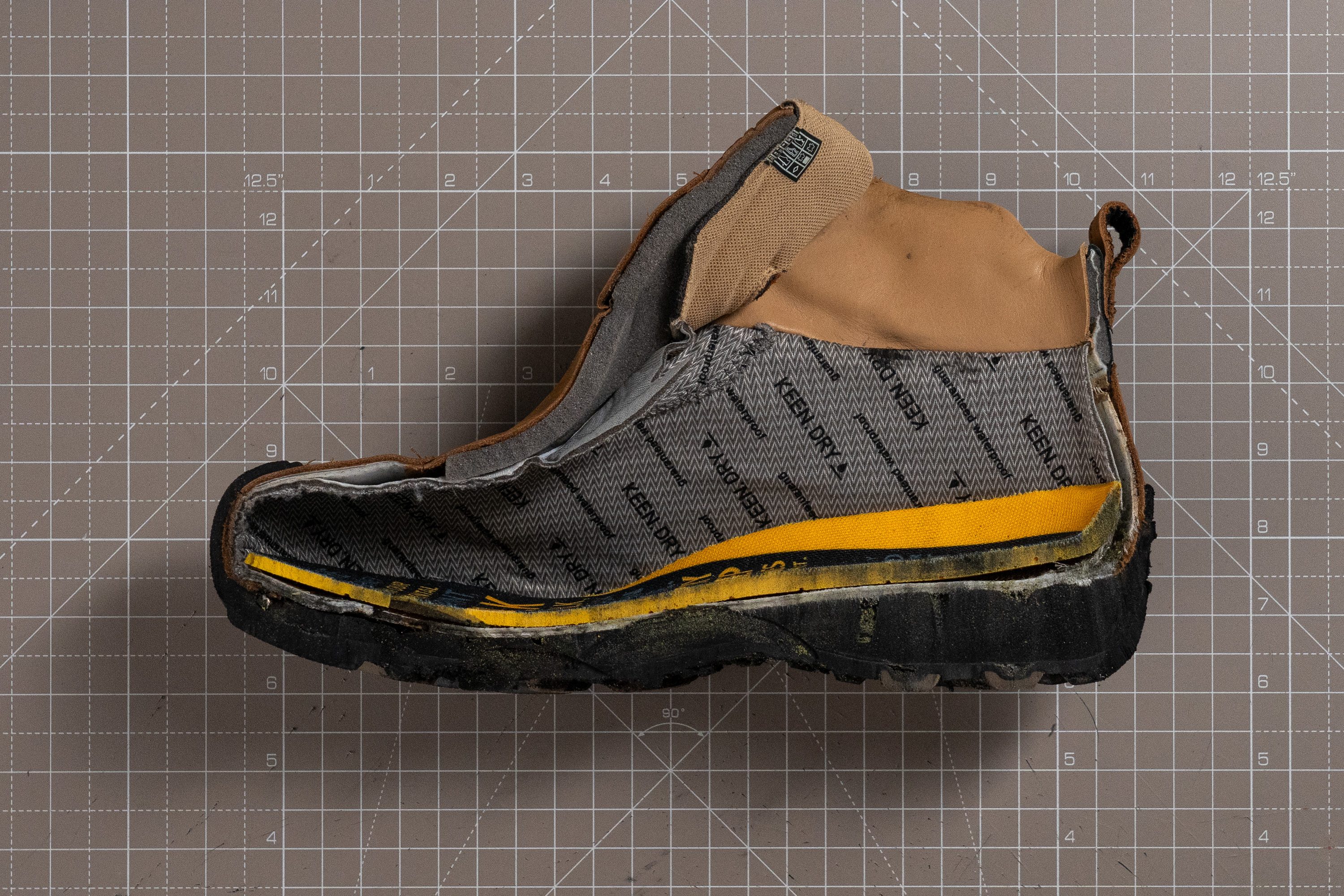
Once we cut these boots in half, we’re able to see whether they have
- A shank, where it is placed, and how long it is
- An insole or no insole, and the feet rest on the lining
- Insulation, how thick it is, and where it is placed
- Layers that would cushion the heel against the back of the boot
- High-quality or low-quality padding, insulation, layers in the midsole, etc.
Durability of leather hiking boots
In our lab, we check the durability of hiking boots in 3 places:
- The toebox
- The outsole
- The heel counter.
For all 3 tests, we use a Dremel. We press it against the boot and assess or measure the damage we’ve made. We always use the same pressure and RPMs to make sure all the boots are treated the same (you can read more on how we test footwear on our Methodology page).
Testing the durability of the toebox on a leather hiking boot using a Dremel
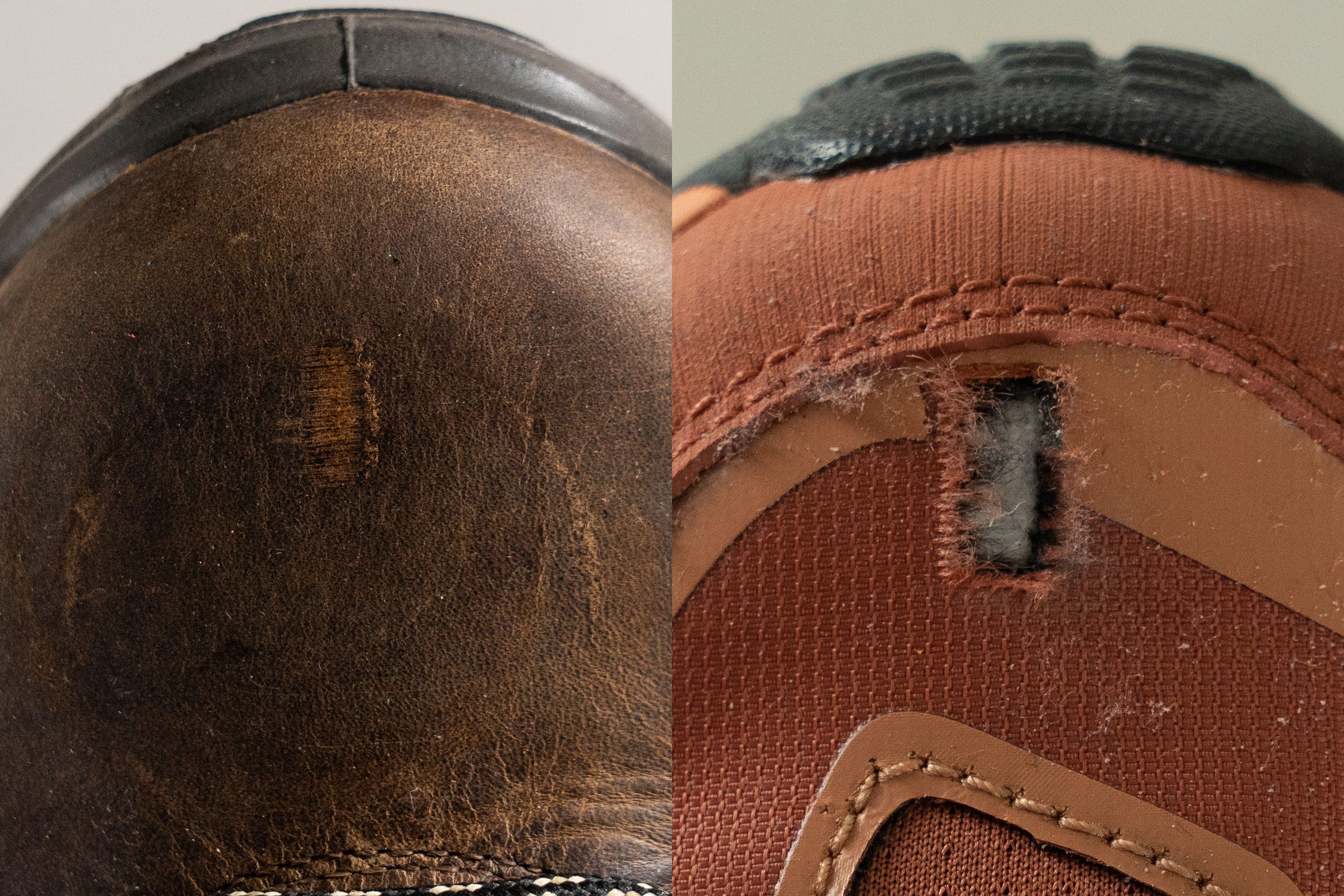
Leather toeboxes tend to be more durable than other materials (rubber toe bumpers excluded, of course). We assess the damage made by the Dremel on a 1-5 scale, where 1 is the least durable.
The quality of the boot on the inside, where the heel slides in, depends on the material. Leather, as expected, holds better than synthetics.
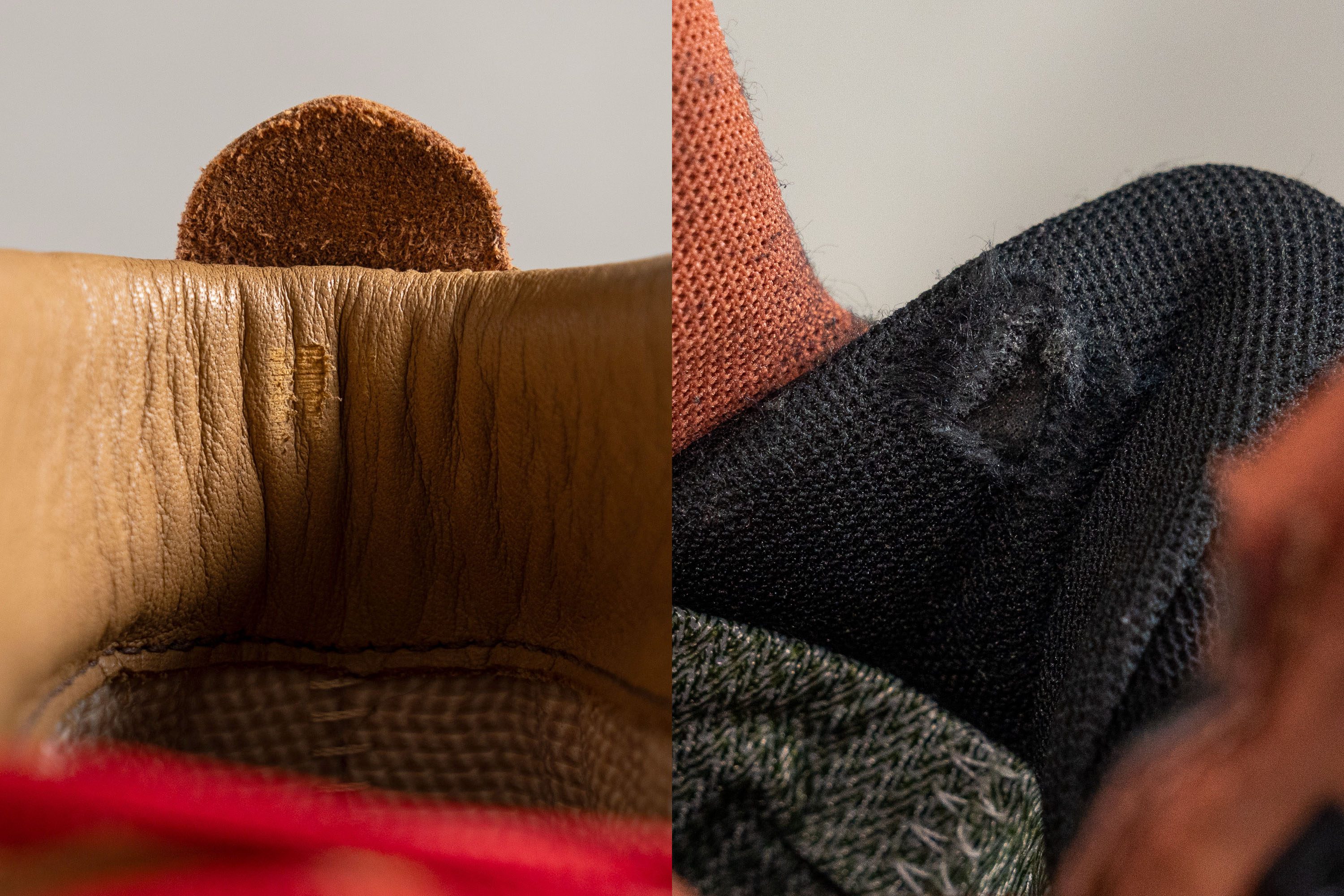
When it comes to the durability of the outsole, leather hiking boots aren’t that different from the rest. Everyone uses rubber for the outsole, so leather here has no influence.
Testing the durability of the outsole rubber on hiking boots
What’s different, though, about this test is that we’re able to precisely measure the damage done by the Dremel. We use a tire tread gauge and the deeper the dent, the less durable the outsole.
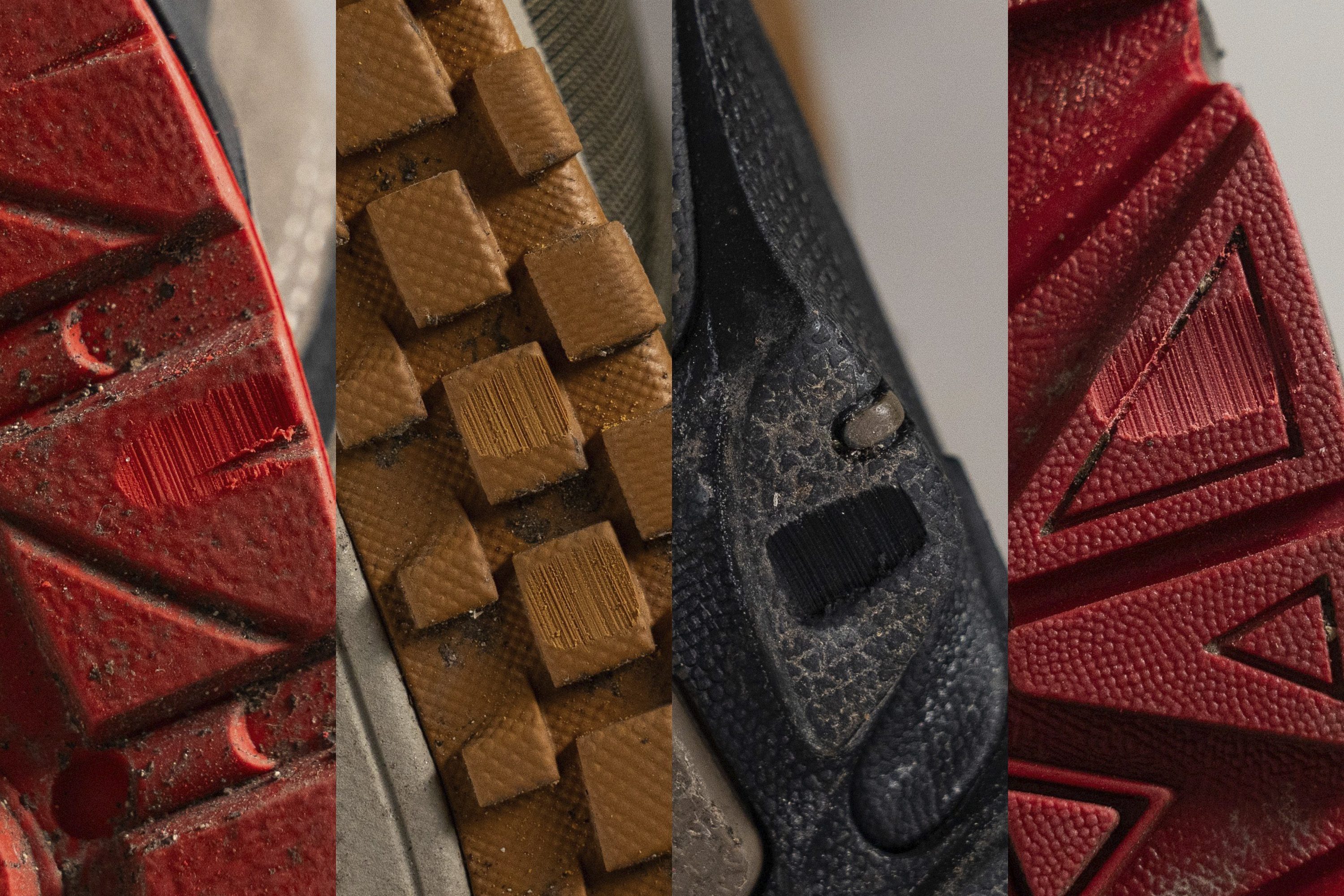
Shock absorption of leather hiking boots
Usually, it's the softness of the midsole that hikers care about. However, we're here to highlight another feature: shock absorption. Why it's so important? Because it tells us how protective the midsole is! Or, in more correct terms, how effective the midsole is at dampening the impact. The higher the shock absorption, the lower the stress that your legs have to deal with.
Performing the shock absorption test in RunRepeat lab
Shock absorption is tightly related to the a) comfort, b) joint protection, and c) fatigue reduction. If you're convinced now that it's an important feature, look at the list of leather hiking boots with great shock absorption:
How breathable are leather hiking boots
Depends on the leather and the upper construction. One-piece upper made of leather will breathe less than those that have some patches made of mesh or synthetic materials, especially with ventilation holes.
Non-breathable vs. breathable hiking footwear on the breathability test
To test this, we pump the smoke into the boot and watch where the smoke comes out and how fast. We assess the breathability on a 1-5 scale, where 1 is the least breathable.
What also helps us understand these test results better is examining the upper under the microscope.
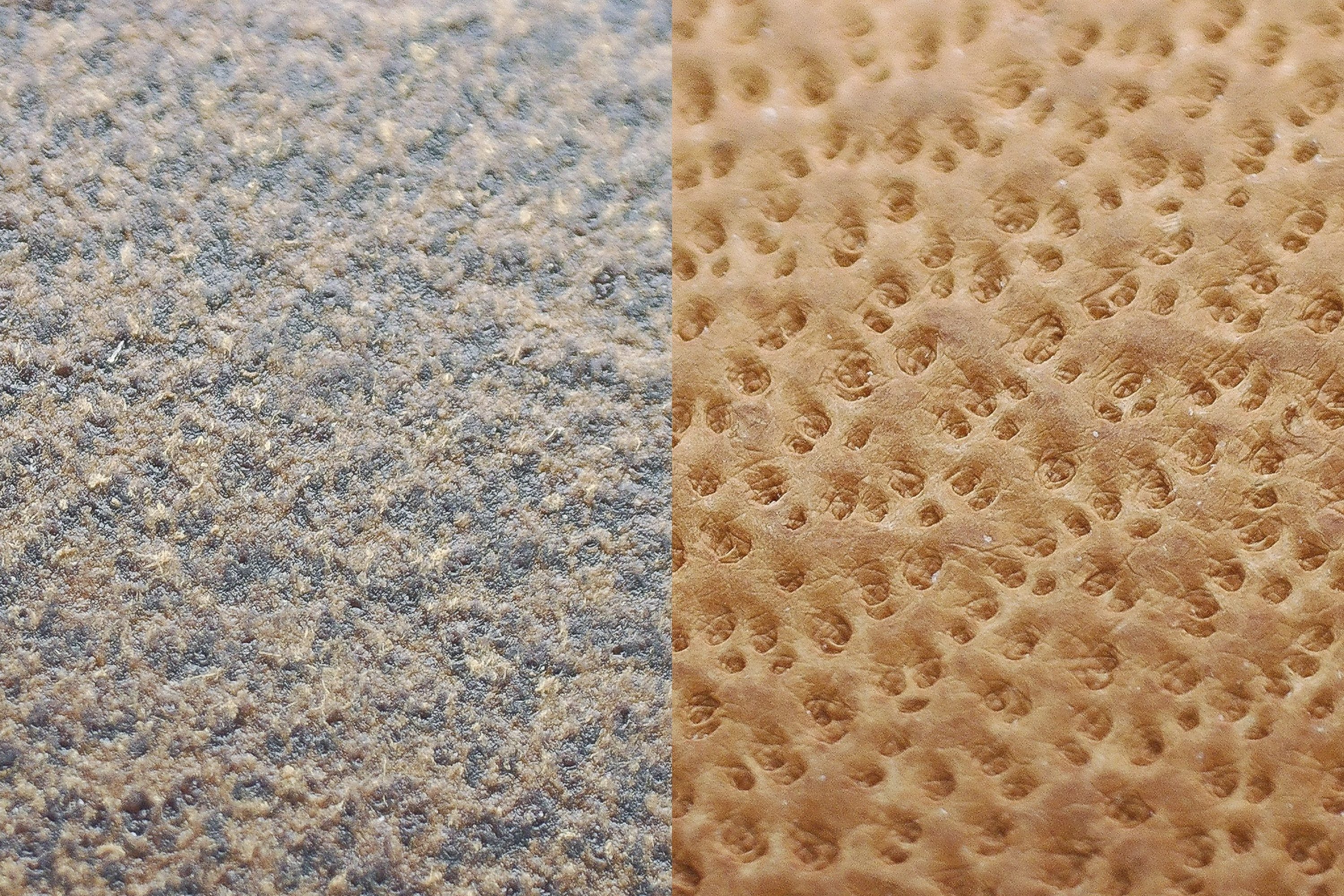
Correct fit of leather hiking boots
If you’re not sure how to go about the sizing and when the boot fits well, here are our tried and tested recommendations:
- Go boot shopping later in the day: in the afternoon or in the evening. By then, our feet are usually swollen up a bit and swelling happens on the hike as well, so we want to try and match those conditions.
- When trying the leather boots on, use your hiking socks. And orthotics, if you have them.
- Once the boot is laced up, sense whether there are any hot spots. There shouldn’t be any.
- Make sure that you have 1 thumb’s width of space in front of your toes when you glue the heel to the back.
- If you’re doing this in a specialized store, use the ramp. Go up and down, sideways, test the boots on various surfaces. It’s important that there is no heel slipping and that your feet are not sliding to the sides (this would mean the fit is too loose).
- Once you’ve bought the boots, break them in. Stiff, dense leather might ask for a longer break-in period so make sure not to rush to the first long hike.
Are leather boots expensive?
Yes, if made of real, high-quality leather.
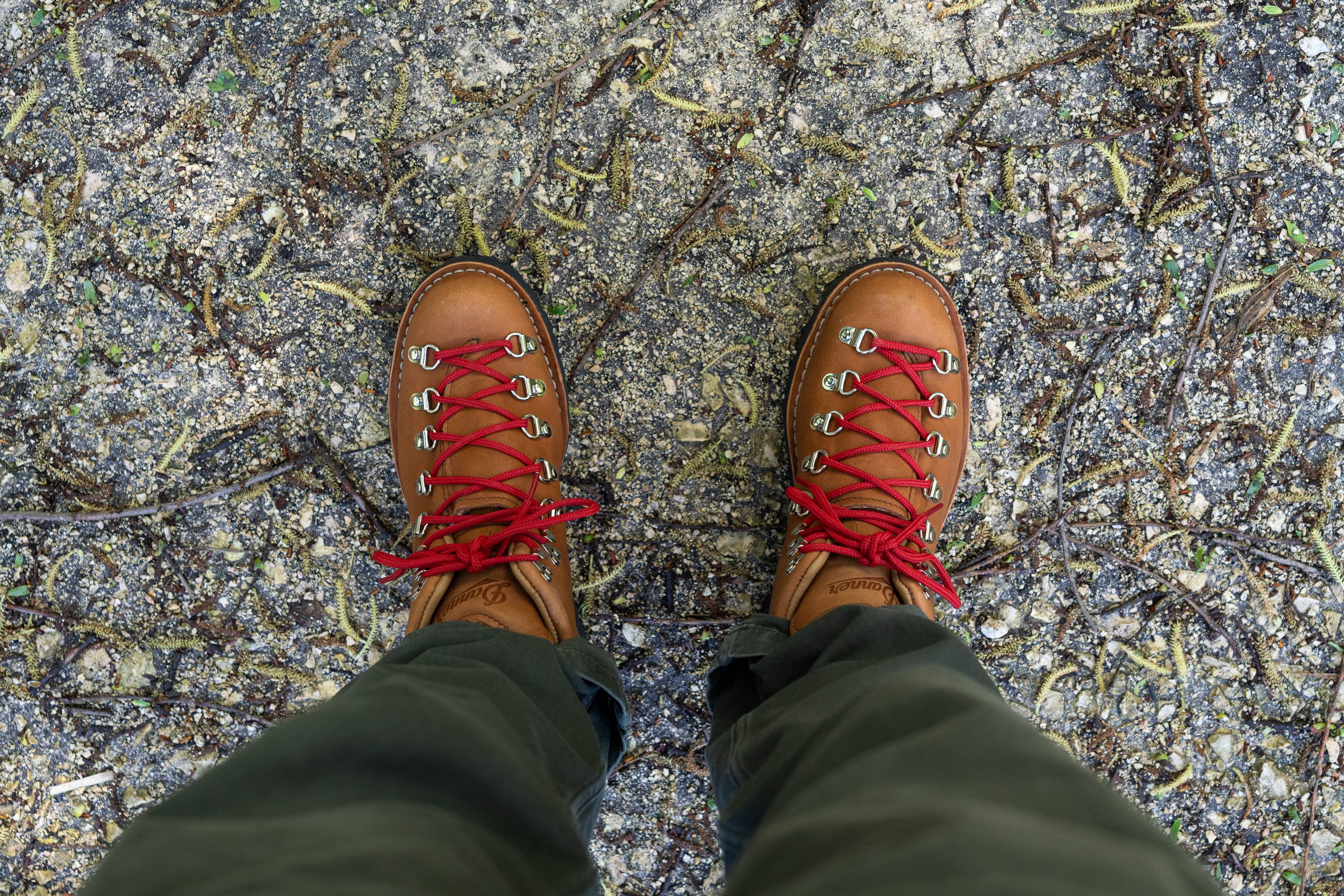
The leather itself, as a material, is not cheap. For context, here are a few relevant data points from our database:
- Average price of all hiking boots: $193.4
- Average price of leather hiking boots: $226.5

